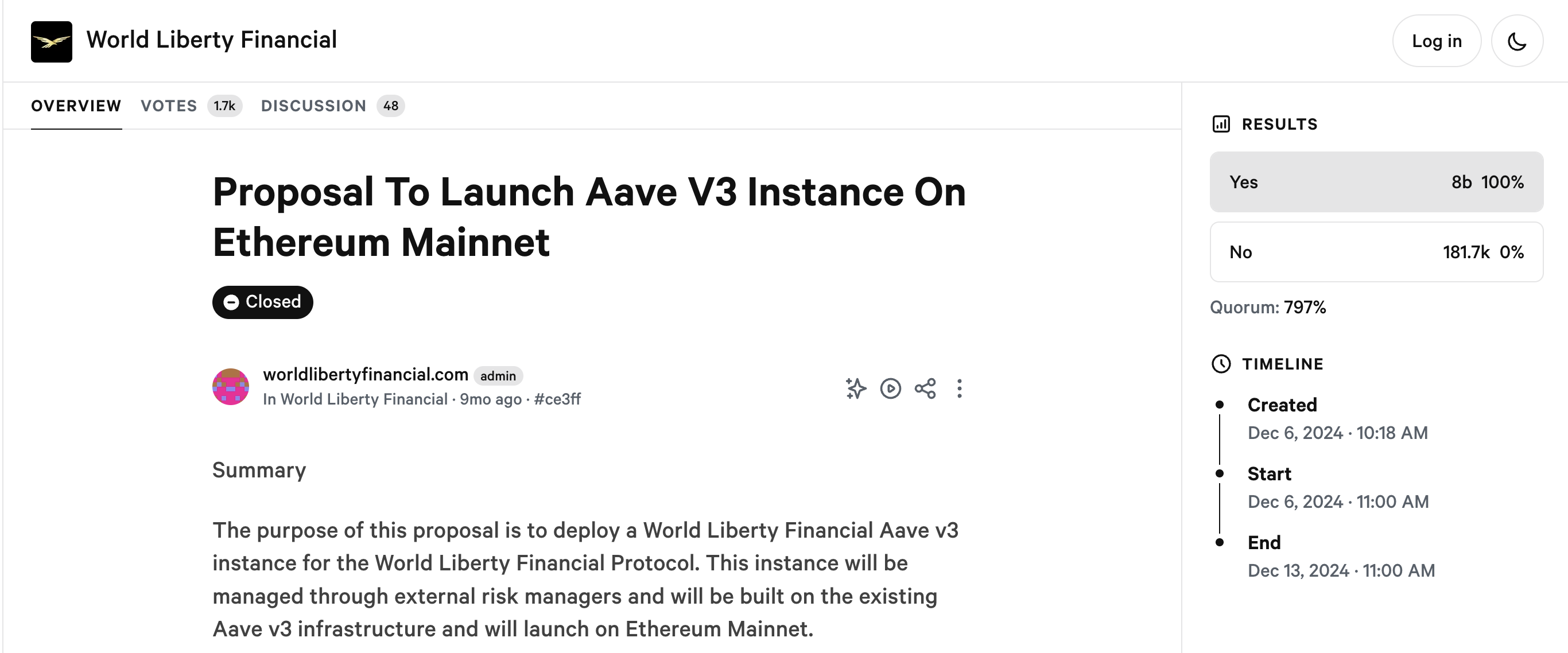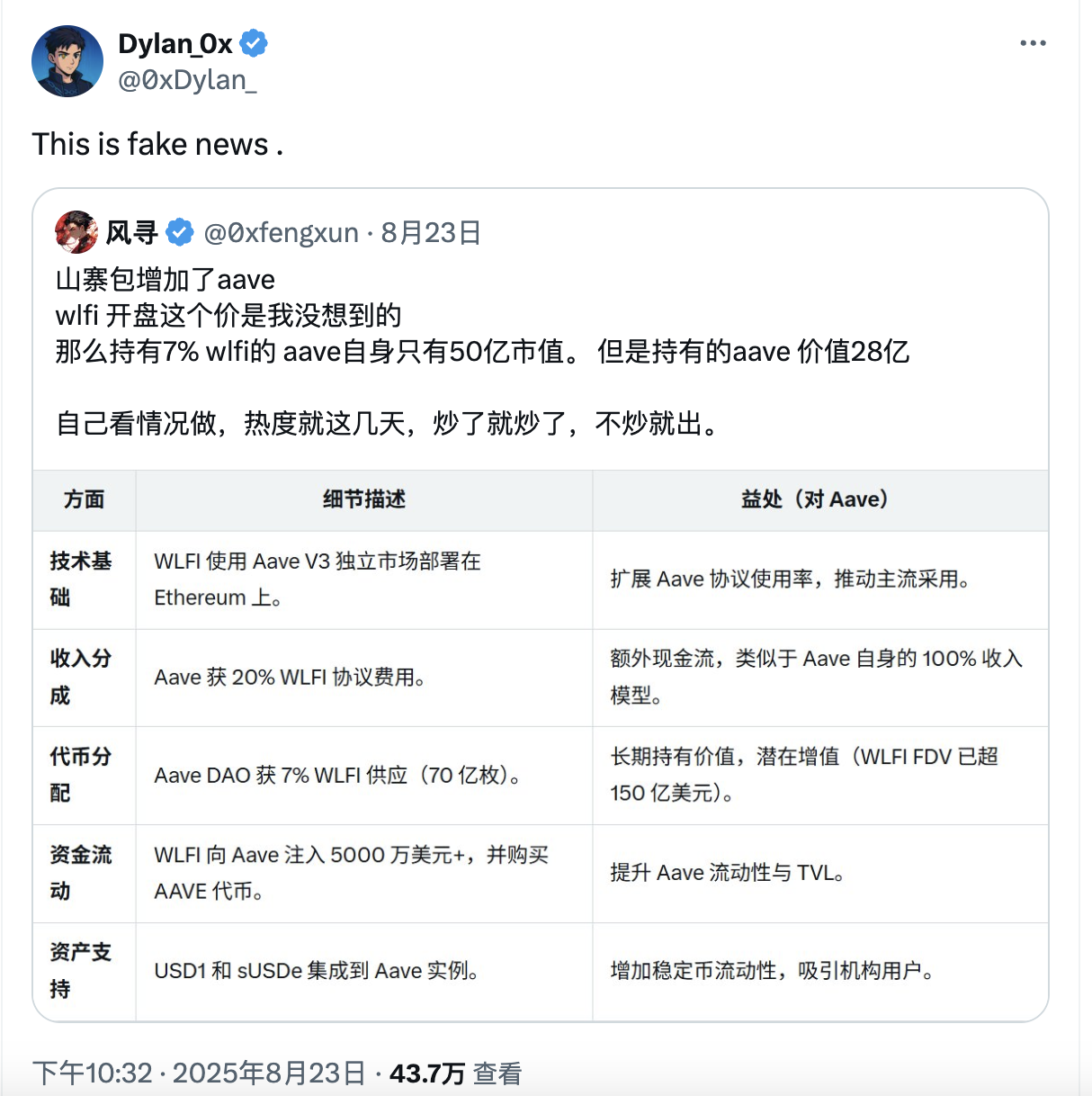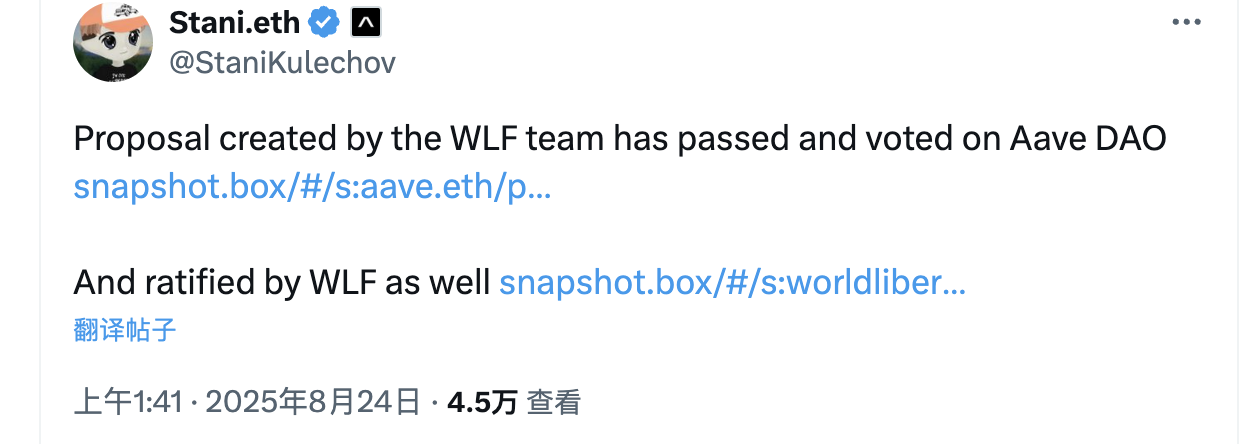Author: Nancy, PANews
Another day, a king-level project is about to debut. The cryptocurrency project World Liberty Financial (WLFI), supported by the Trump family, is set to launch on the Ethereum mainnet, with an extremely high market valuation and astonishing early returns quickly making it a hot topic in the crypto circle. However, WLFI has also fallen into a whirlpool of public opinion due to controversy over its profit-sharing proposal with Aave, sparking market discussions and reflections on this on-chain governance drama.
WLFI Set to Launch on Ethereum, Early Investors Could See Up to 14x Returns
On August 23, WLFI announced that it will launch on the Ethereum mainnet on September 1, at which point users can claim and trade tokens. Among them, early supporters (at $0.015 and $0.05 rounds) will unlock 20%, while the remaining 80% will be decided by community vote. Tokens for the founding team, advisors, and partners will not be unlocked at launch.
Following the launch announcement, exchanges such as Binance, OKX, and Hyperliquid announced pre-trading for WLFI/USDT perpetual contracts, with the contract price briefly soaring to $0.55, corresponding to a fully diluted valuation of about $55 billion. However, the price quickly fell back, with pre-trading prices dropping over 60% to around $0.20.

WLFI was announced by the Trump family in September 2024, and has publicly conducted two rounds of fundraising to date. The first presale began on October 15, 2024, when WLFI announced it would release 20 billion tokens to whitelist investors at a price of $0.015 each. However, market response was tepid, with approximately 610 million WLFI sold on the first day (with 19.4 billion remaining for sale), generating only $9.15 million in sales. Due to the weak market response, WLFI submitted an application the following month to significantly reduce its fundraising target by 90%, adjusting the goal to only $30 million.
However, after Trump won the U.S. election, WLFI token sales began to accelerate, ultimately selling out 20 billion tokens by January 20, 2025, and generating approximately $300 million in revenue. During this period, Tron founder Justin Sun made two rounds of investments of $30 million and $45 million, becoming the largest individual investor in this round of fundraising, while also serving as an advisor to WLFI.
On January 20, 2025, coinciding with Trump's inauguration, WLFI launched its second presale, announcing an additional 5% of the token supply, with the price increased to $0.05. Compared to the first round, this presale saw a strong response, selling out in just two months by March 14, successfully achieving a fundraising target of $250 million.
According to WLFI's tokenomics, the total supply is 100 billion tokens, with 35% allocated for token sales, 32.5% for community growth and incentives, 30% for initial supporters, and the remaining 2.5% for the team and advisors. From the current public offering progress, WLFI has completed 25% of the total supply, with 10% still available for sale.
If calculated at the current pre-trading price of $0.21, investors at $0.015 would see a floating profit of about 14 times, while participants at $0.05 would see a floating profit of about 4.2 times. Additionally, on-chain analyst Ai Yi disclosed that the top 10 addresses in WLFI's public offering round have collectively invested $73.08 million, holding a total of 4.63% of the tokens, or 4.64 billion tokens. Based on the current price, this portion of investors will unlock tokens worth over $190 million at TGE.
Furthermore, WLFI's market maker situation has also been disclosed. According to Ai Yi's analysis, DWF Labs is undoubtedly WLFI's market maker, and there will likely be other market makers as well. Data shows that Web3Port acquired 200 million WLFI tokens (cost $0.05) in the strategic round, DWF Labs acquired 250 million tokens (cost $0.10), and ALT5 Sigma Corporation obtained 7.5 billion tokens through equity acquisition (cost $0.20).
It is worth noting that DT Marks DEFI LLC, associated with the Trump family, is entitled to 75% of the net income distribution from the agreement, while bearing no responsibilities. During the public offering process, DT Marks DEFI LLC's share has decreased from the original 75% to about 40%.
7% Token Distribution Proposal in Doubt, WLFI and Aave Stand Firm
While the high returns for WLFI's early investors have sparked heated discussions, rumors about Aave potentially receiving 7% of the total WLFI tokens have also led to ongoing community disputes. The WLFI team has denied this, but Aave insists that the agreement is still valid, with both sides holding firm to their positions.
The incident can be traced back to before WLFI's official launch. At that time, WLFI revealed plans to provide crypto lending services on the Ethereum blockchain and stated in their official Telegram channel that they were collaborating with Aave, emphasizing that this was not a malicious fork, but rather an effort to create an innovative platform to drive the DeFi industry forward.

In early December 2024, WLFI proposed its first community proposal, planning to deploy an Aave v3 lending instance for the WLFI protocol on the Ethereum mainnet, initially supporting USDC, USDT, ETH, and WBTC, managed by Aave's risk management team. The main goal of the proposal was to attract users new to DeFi and enhance the recognition of the WLFI and Aave brands. In return, the proposal stated that AaveDAO would receive 20% of the protocol fees generated by the WLFI Aave v3 instance and approximately 7% of the total WLFI tokens (7 billion tokens) for participation in WLFI's future governance, liquidity mining, and promoting platform decentralization. The revenue distribution plan would be executed through a trustless smart contract, proportionally distributing to AaveDAO and the WLFI treasury address. This proposal was voted on and passed on December 13, 2024, with a support rate of 100%.
As WLFI's launch approaches, this proposal has recently been brought back up by the community, directly driving up the price of AAVE. Based on current market valuations, the Aave treasury could receive WLFI tokens worth billions of dollars, making it one of the potential biggest beneficiaries in this cycle.

However, this positive news was denied by suspected members of the WLFI Wallet team, and the WLFI team responded to Wu Shuo Blockchain, stating that the claims were false and were "fake news." In response, Aave founder Stani.eth insisted that the agreement is still valid, emphasizing that this proposal was created by the WLFI team and received formal approval.

As the news develops, the crypto community continues to debate this incident, with varying opinions. Crypto KOL @0x_Todd pointed out that this is WLFI's genesis proposal (the first proposal), with the number of voters exceeding the legal voting threshold by seven times and a support rate above 99%. If even the genesis proposal is not fulfilled, it is very un-DeFi. Centralized governance is no longer DeFi, and governance breaches should be expelled from DeFi.
KOL @Luyaoyuan1 warned that WLFI may face default risks, citing historical precedents where similar SPK projects significantly reduced promised returns, and Aave has been deceived multiple times. If there is a default, Aave should sue WLFI.
dForce founder Mindao directly stated that the initial "20% revenue sharing + 7% token distribution" clause design is unreasonable and does not match WLFI's actual brand and market value. He analyzed that the subsequent script is likely WLFI completely abandoning Aave, thus rendering the previous contract void. At the same time, WLFI could massively reduce the token distribution share, reallocating it to incentivize USD1 lending minting, benefiting both sides.
"Previously, WLFI's public sale was not smooth, and external doubts about its potential to exploit investors put Aave in a strong position in the collaboration. However, with market enthusiasm surging, the stablecoin genius bill passing, and Trump's personal financial disclosure holding 15.7 billion WLFI, its value status has risen, making WLFI reluctant to share as much cake with Aave as before," @wenser2010 analyzed, suggesting that Aave may need to make concessions, reducing its original share, or WLFI may push for a new proposal to redistribute revenue proportions. The duration will depend on the negotiations behind the scenes.
However, Mint Ventures research partner Alex Xu pointed out that WLFI initially wanted to create a lending market based on Aave, but later may have found lending too unappealing (despite having proposed token and profit distribution plans), shifting towards stablecoins. If that is the case, the cooperative relationship between the two parties no longer exists, and WLFI's official white paper has never mentioned Aave.
Although the controversy over WLFI's collaboration with Aave remains unresolved, this incident once again exposes the limitations of on-chain governance. While on-chain governance has advantages such as transparency and decentralization, even if a proposal is passed by community vote, actual implementation still depends on the willingness and negotiation results of all parties involved.
免责声明:本文章仅代表作者个人观点,不代表本平台的立场和观点。本文章仅供信息分享,不构成对任何人的任何投资建议。用户与作者之间的任何争议,与本平台无关。如网页中刊载的文章或图片涉及侵权,请提供相关的权利证明和身份证明发送邮件到support@aicoin.com,本平台相关工作人员将会进行核查。




